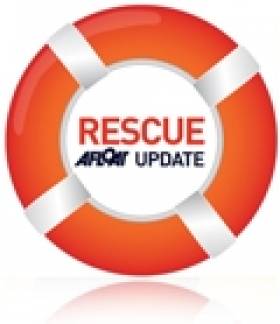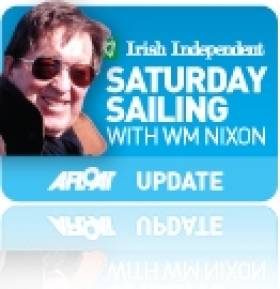Displaying items by tag: Norman Kean
#safetyatsea – Last Thursday (April 16) the Department of Transport published its Maritime Safety Strategy, resulting from the "Sea Change" consultation last year. By chance this coincided exactly with our publication of the ICC's independent analysis of the Marine Casualty Investigation Board reports which form the background to the programme. Norman Kean has now reviewed the latest proposals.
The new Maritime Safety Strategy contains much sensible encouragement, and also 33 proposals for action by the Irish Maritime Administration, under five headings. These include:
• "Intensification of efforts to promote maritime safety awareness through a process of information and communication, and the promotion of more effective communication between key stakeholders"
• "An appropriate regulatory regime for the seaworthiness of vessels and craft and the competency of operators and/or crew"
• "Building on the current enforcement regime."
What does this mean for leisure sailors? Under the Information and Communication heading are some sensible proposals, such as widening the membership of the Marine Safety Working Group, organising an annual maritime safety conference to be open to the public, and addressing children and young people through the education system. This goes some way to recognizing the fact that the people most at risk are not connected to the established organization of sailing clubs and training systems. Lack of awareness is the biggest killer of all.
"Appropriate regulatory regime" translates into the intent to update the Code of Practice for Safe Operation of Recreational Craft, starting in 2016. It is to be hoped that this will be done in a proportionate and well-informed manner, and that the word "should" in respect of things like carriage of equipment does not too often morph into "must". Perish the thought that we might be required by law to submit our boats to annual Government inspection, that we should be compelled on pain of prosecution to report every single arrival and departure to Coast Guards or Harbourmasters, that we might be forced to transmit AIS signals all the time on pain of a fine. All those and many more have been suggested in submissions at the consultation stage of this process. This must not be the thin end of the wedge. Transmitting AIS is undoubtedly a good idea in busy waters, but the accident statistics don't support making it compulsory. We do not need, and we certainly do not want, a Big Brother regime, and the absence of any explicit proposals in that direction is to be welcomed.
Starting in 2017, jet skis and many small speedboats will have to be registered, as defined in the new Registration of Ships Bill, and it appears that the timeline for a new voluntary small craft register will start in 2018. This is far too late. The lack of such a facility for the next three years will leave many owners with no choice but to flag out to other EU states, to avoid facing voyage restrictions and having Irish yachts, at present abroad, put at risk of being impounded for lack of ship's papers.
But it begs the question, what does all that have to do with safety? Might the mention of registration here be a step in the direction of inspection - and ultimately taxation?
A new focus is proposed on more rigorous enforcement of existing legal requirements, with extension of on-the-spot fines for breaches of lifejacket laws quoted. That particular example is common sense and should be applauded by all responsible sailors. The great majority of recreational craft fatalities occur in small open boats and the majority of casualties are not wearing lifejackets when they should be. Conspicuous enforcement would get the attention of those most at risk. Last summer we came across a speedboat grossly overloaded with eleven people aboard; none of the five adults was wearing a lifejacket. If the skipper had been met on the pontoon by a couple of burly Guards who promptly relieved him of several hundred euro, the word might get round and the message might get through. But there must be no mission creep. I was once, at the helm, accosted by a Coast Guard crew who asked me, none too gently, where my lifejacket was, to which I replied that it was safely in its locker, that this vessel was 16 metres in length and perhaps they would care to read their own rules.
Under "Data and Evaluation" it is proposed to commission a baseline study of attitudes to maritime safety. The sailing clubs of Ireland need to be proactive in taking part in that. In respect of cruising sailors, the RNLI is currently doing exactly the same thing, and we must hope that the Maritime Administration takes the results of that study fully into account. Despite the rising trend in callouts to recreational craft, the RNLI continues to be firmly in favour of education over compulsion.
#WaterSafety - The Government's 'Sea Change' consultation contained sobering statistics on boating fatalities in Irish waters, prompting calls for much tighter water safety regulation. But as Irish Cruising Club spokesman and Sailing Directions Editor Norman Kean writes, that view is not shared by all in the marine sector...
In June 2014, the Department of Transport issued a consultation document titled 'Sea Change', in which it was alleged that over an 11-year period, 66 fatalities had occurred on recreational craft. This represents 47% of all marine fatalities in the period, and the figure was widely and sometimes sensationally reported.
In light of that, it's worth examining the following extracts from the Irish Cruising Club's (ICC) submission to the department, which reflects an independent study of the original Marine Casualty Investigation Board (MCIB) reports:
The MCIB reports for the period 2002 to 2012 describe 42 incidents involving craft other than licensed commercial or fishing vessels. Presumably these are classified, by default, as leisure-related. These 42 incidents resulted in 51 deaths. We believe it is significant and worthwhile to note that 28 of these fatalities (55%) occurred when the purpose was not recreational boating per se. Twenty-two people lost their lives while out fishing, five while ferrying or as passengers, and one on a hunting trip by boat. The remaining 23 comprised eight kayakers/canoeists, three jet-skiers, five sailing and seven power-boating, each activity in these 23 cases being carried out for its own sake.
There is circumstantial evidence to suggest that of the 22 'recreational' fishing casualties, at least 10 may have actually been out for commercial purposes. The same applies to at least two of the 'ferrying' category. We have knowledgeable independent support for that view.
Sixteen casualties, including the eight kayakers, lost their lives in rivers or lakes, and 35 in tidal water.
Sixteen of the 51 deaths occurred between November and April, not a time of year normally associated with recreational boating.
Most incidents involved small open boats; all but five vessels were under seven metres in length. One of those five was a 7.3-metre undecked gleoiteog.
Perhaps the most telling statistic is that in 32 cases, lifejackets were inaccessible, faulty or badly adjusted, or not worn when they clearly should have been. This, and much else described in the MCIB reports, indicate a disturbing recklessness and lack of awareness on the part of the casualties and their companions.
The discrepancy between the figure of 51 deaths investigated by the MCIB and 66 quoted in the consultation document presumably reflects the inclusion of diving, surfing and sailboarding casualties as 'recreational craft' accidents. These do not fall within the remit of the MCIB, for a good reason: diving is a specialised skill, and accidents seldom if ever have anything to do with the operation or actions of the boat; while a surfboard is not a boat.
The submission also goes on to say that "almost every one of the [nine contributory causes listed in the consultation document] is in turn a result of the above-mentioned lack of awareness, and... if that lack could be adequately addressed, many issues like 'failure to plan journeys safely' and 'vessel unseaworthy, unstable and/or overloaded' would simply no longer arise. This is the commonplace observation of every skilled and experienced recreational sailor; we see it all the time."
Our point was – of course - that the representation of recreational sailing as being particularly hazardous was a grossly unfair interpretation of the statistics.
The ICC was the only yacht club in Ireland to respond (the ISA also sent in a submission) and the RNLI was the only other organisation not to take the department's figures at face value. There were 36 submissions in total, many of them from professional organisations such as the Harbourmasters, the Irish Lights, the Naval Service, the Irish Coast Guard and the Institute of Master Mariners. Almost without exception these bodies and individuals wanted leisure craft and their crews to be highly regulated, sometimes to an utterly draconian extent.
In general, none of their recommendations would have the slightest effect on accident rates or consequences unless implemented with a zeal worthy of the Taliban. What they would undoubtedly do is make life easier and less stressful for the watch officer on the bridge of a ship or in the coastguard station, which one can well understand.
It is worthy of note that the RNLI and Irish Water Safety shared our view that education was preferable to regulation.
Uncharted Rocks & Revised Depths Round Ireland
#unchartedrocks – The survey ships of the INFOMAR project – the Marine Institute's Celtic Voyager and the Geological Survey's Keary, Geo and Cosantoir Bradan – have been busy recently, and a lot of previously uncharted rocks have now been surveyed and notified to the UK Hydrographic Office for inclusion on the charts writes Norman Kean of the Irish Cruising Club. A couple of known rocks have also had their depths revised shallower, and would now be recognised as a significant hazard to small craft.
The most important new discoveries are these (Admiralty Notices to Mariners numbers in brackets):
• Rock with 2m, 2 cables off Rush Bay (1381/2014)
• Rock with 1.2m, 2 cables east of Loughshinny pier (1381/2014)
• Rock charted at 3.4m, north-east of the Fastnet, re-surveyed at 2.2m (0496/2014)
• Rock with 0.8m, halfway between Colleen Og Rock and the shore, at Dingle
• Numerous rocks around Inishskinny and south of Inishbofin (2672/2014)
• Rock with 1.5m, 2 cables south-east of Knife Rock, at Benwee Head in Mayo (3994/2014)
• Ballyhiernan Rock, west of Fanad Head, resurveyed from 3.4m to 1.7m (2620/2014)
The leisure sailing community has also made its contribution. A rock with 0.1m was discovered in Crookhaven Harbour in July by the crew of the yacht Eleanda (3645/2014). Fortunately she didn't hit it, but when they looked over the stern at low water on their anchorage, there it was, lurking a metre down. And very, very solid.
Not every change has been for the shallower – Limeburner Rock, off north Donegal, has had its depth revised from 2m to 3.5m.
It may be true that the rocks don't move, but the ever-increasing accuracy of the charts means that our knowledge of their existence, position and depth is constantly improving. Don't assume that your chartplotter package will pick this up automatically – it's best to check. The relevant Notices to Mariners can be found on www.ukho.gov.uk.
Irish Cruising – Sailing's Magic Elixir for a Long Life
#cruising – Cruising is the hidden side of sailing, yet it's the choice for the majority of those going afloat. Whether it's day cruising, a longer venture in the annual holidays, or the dream cruise of a lifetime across oceans, this is our sport. Unlike racing, which generates its own narrative even if only through the recorded results, much of cruising would slip under the radar completely were it not for cruising awards. W M Nixon considers the latest annual batch from the Irish Cruising Club.
Cruising under sail seems to be the secret of eternal youth. Last night's Annual General Meeting of the Irish Cruising Club in Dun Laoghaire saw a distribution of awards to voyagers from all parts of Ireland who sailed successfully in many areas of the globe in boats mostly of modest size. Yet any outside analyst would soon have made the point that many of the achievers were of mature – sometimes very mature - years, and fulfilling a retirement dream.
But despite any ICC membership gathering these days being a sea of silver heads, age is the last thing they think about. This club of 550 members has become the mixture of an Active Retirement Association – very active indeed, as it happens – and a sort of seagoing extension of the Men's Shed movement.
If you were looking for an illustration of Ireland's changing demographics, and our very rapidly changing attitude as to what constitutes old age, you need look no further than the ICC. Time was when it was thought quite something when one of the club achieved the Golden Jubilee of their membership. But these days, it's no big deal to have been on the strength for fifty years, as the senior member is Joe FitzGerald of Crosshaven, who this year marks 70 years in the club, and he is closely followed by Douglas Mellon who joined in 1947 from Howth - he now lives on the Scottish Riviera in Kircudbright.
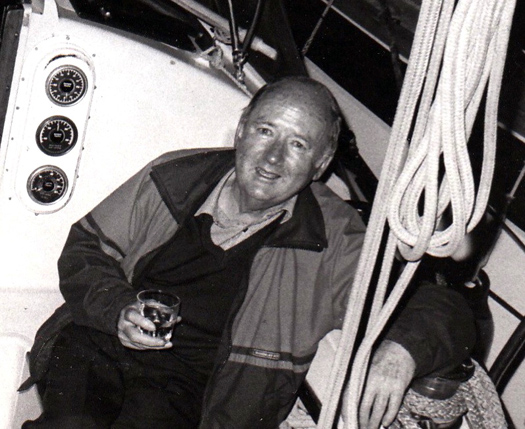
Joe FitzGerald of Cork is the ICC's most senior member, having joined in 1944. He served as Commodore from 1984 to 1987.
All those years ago when they took up their membership, it was thought perfectly normal for young men – married or otherwise - to take off for at least a fortnight's cruising every year, regardless of family demands which these days would be regarded as the prior commitment. In fact, nowadays so much emphasis is placed on family life and families doing just about every last recreational thing together, that younger married sailing people either do extremely short-hop cruising of the type necessitated by catering for the needs of all the members of the family, or else they don't cruise at all in the traditional sense - "Fun For All The Family" effectively rules out proper cruising.
Then too, modern life has so many other distractions - not least of them work demands which involve 24/7 attention - that the old-style easygoing simply-wandering-along holiday cruising is very much a minority activity. This means that at first it seems young people are not taking up traditional cruising at all. But with its deep experience garnered since its foundation in 1929, the Irish Cruising Club has learned to take the long view. It is not unduly concerned by the steadily rising age profile of its membership, and certainly every year there is a significant group of sometimes quite senior yet nevertheless increasingly active cruising enthusiasts joining the club.
They're the embodiment of the slogan that Sailing is a Sport for Life, and it's only politeness which prevents them saying that the subtle pleasures of cruising are wasted on the young. So when you look at the lineup of achievement represented by last night's awards, it's natural to wonder what these people did in earlier life, that they can nowadays afford the time, resources and dedication necessary to complete voyages of this quality.
The adjudication was done by Dave Whitehead of Kinvara on Galway Bay, himself no stranger to the ways of the sea while making long voyages in small craft. He breaks new ground by awarding three trophies at once to Sam Davis of Strangford Lough, whose Cape Horn and Pacific ventures with his Rival 41 Suvretta have been quietly bubbling away in the background of ICC activity for the past three years.
Sam Davis first featured in Afloat magazine in March and April 1981 when we ran his two-part account of his first ocean voyage, an Atlantic circuit from Strangford Lough between 1976 and 1979 with the 34.5ft West Solent Class Suvretta, a former racing boat he'd found in a derelict state and restored to ocean-going condition.

The 34ft West Solent class Suvretta in her offshore racing days in the 1950s when she was based in Belfast Lough. When Sam Davis did the Atlantic Circuit cruise with her in 1976-79, she carried a less loft mainmast, with masthead rig.
But even with Sam's improvements, she was still no more than a slip of a boat, so it says much for his grit and skill that he brought her through the Fastnet storm of 1979 as he sailed the final hundred miles back to Ireland. There was damage aloft, and he'd to get into Dunmore East unaided with jury rigging, but the job was done.
While in the Caribbean, he'd worked in charter yachts between times to make a shilling or two. But after he'd spent time back in Northern Ireland, he went abroad into serious seafaring in offshore service industries, working in places like The Gulf, the North Sea, the Amazon, the Red Sea and Malaysia, becoming a fully accredited Marine Consultant.
Yet if you ask him nowadays what he is and what he was, he'll say he's a farmer and former seaman, as his purchase some years ago of Conly Island in Strangford Lough (you can drive out to it when the tide is down) gives him the little bit of land, and an anchorage too, while "seaman" covers his many experiences in offshore work.
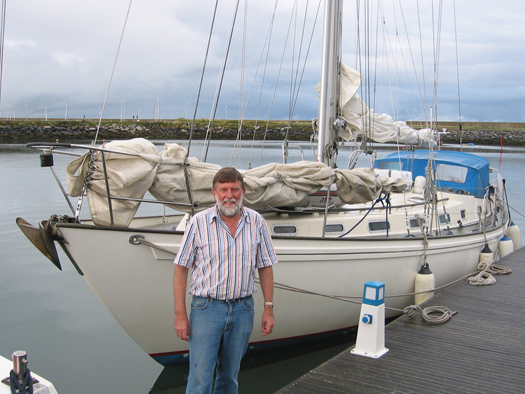
Sam Davis with his newly-acquired Rival 41, re-named Suvretta, in 2009. Photo: W M Nixon

Suvretta in the Beagle Channel in southern Chile. Photo: Sam Davis
Back in 2009 he bought a Rival 41, a hefty and able vessel, a sister-ship of Waxwing in which fellow ICC members Peter and Susan Gray of Dun Laoghaire went round the world 14 years ago. Sam re-named his new boat Suvretta, spent the winter sorting her out, and in 2010 he was gone, sailing south single-handed to eventually round Cape Horn and then spend a long time on the coast of Chile. He was delayed there as a ship broke drift and damaged the boat, but it was well fixed, and he voyaged on into the Pacific to many islands, including Pitcairn and the Tahiti group.
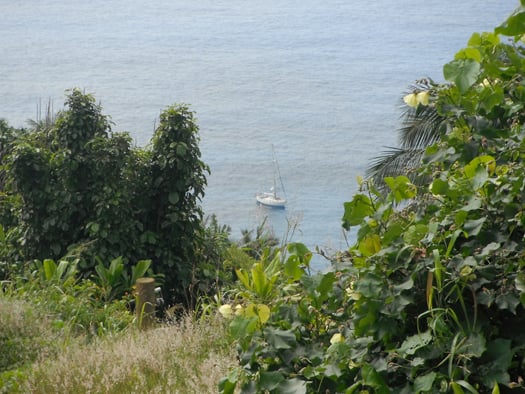
Restless anchorage. Suvretta in Bounty Bay on Pitcairn Island. Photo: Sam Davis
Eventually he fetched up for some time in Tonga, where he became enthused about the 73ft Vakas, the Pacific islanders' contemporary take on the classic Polynesian inter-island vessels (see Sailing on Saturday 11th January 2014). But by November 2012 it was time to head for home, so Suvretta sailed southeast for Cape Horn non-stop, and having rounded it, shaped her course for Port Stanley in the Falklands.
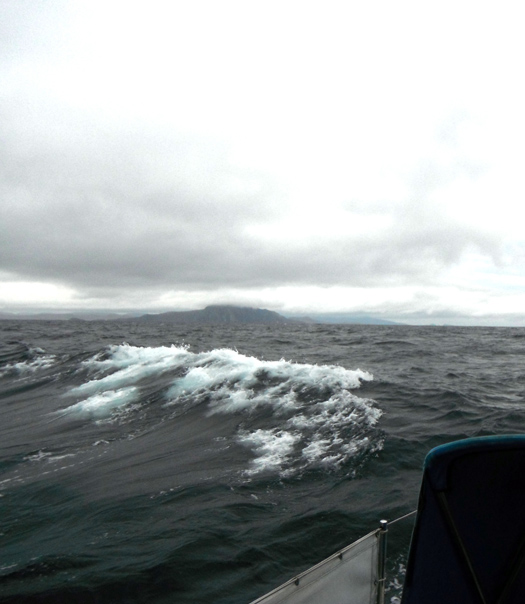
Suvretta rounding Cape Horn for the second time, 21st January 2013. It was only when the Horn was well astern that the weather deteriorated rapidly to make for a challenging approach to Port Stanley. Photo: Sam Davis
However, while rounding the Horn had been simple enough, the passage onwards to Stanley became increasingly fraught, running before rising storm force winds. Conditions were such that it looked for a while as though the lone sailor was going to be swept right past the islands, but he made the cut into shelter to such a nicety that he is awarded the ICC's Rockabill Trophy for Seamanship.
And then when Port Stanley was reached, a very fine passage had been completed from Tonga, so last night for that he was additionally awarded the ICC's Atlantic Trophy for the best voyage with a non-stop leg of more than a thousand miles. And then finally, after they'd spent the mid part of 2013 working their way up the Atlantic with the lone skipper particularly enjoying himself at ports on the Irish coast, Suvretta and Sam returned after three years to Conly Island. And they'd now done more than enough to also be awarded a third trophy - the ICC's premier honour, the Faulkner Cup.
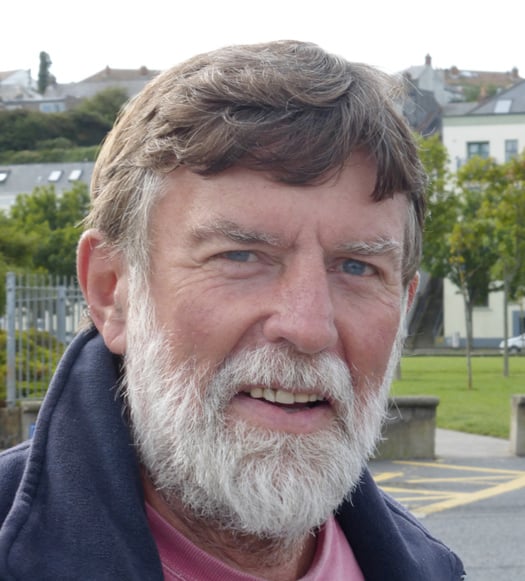
Home again. Sam Davis back in Ireland, August 2013. Photo: W M Nixon
With such a high level of activity by many members, ICC adjudicators always find some final choices to be a very close call, so some years ago the Strangford Cup was inaugurated for the cruise which almost won the Faulkner Cup. This year it has gone to a fine cruise from Portugal to Madeira and through the Azores in detail before returning to Portugal.
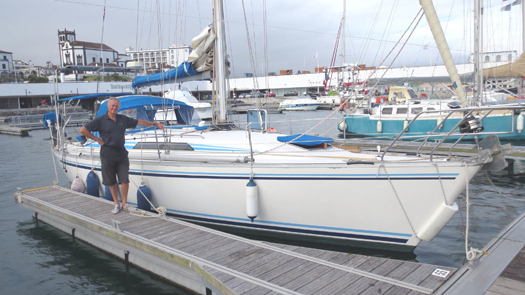
John Duggan with his MG CS40 Hecuba in Horta in the Azores
John Duggan originally hailed from Malahide where he sailed, and he also sailed with the college teams while at Trinity College in Dublin. He cruised and raced offshore mostly in the Irish Sea, but having qualified as an accountant he decided to spread his wings internationally, and he became one of those key people who turn up as partners in one of the big four accountancy firms worldwide.
Eventually his career brought him to the company's offices in Lisbon. Living in Portugal suited him fine, so he put down roots and in time bought himself an interesting cruiser. Hecuba is a 1989 Canadian-built Tony Castro-designed MG CS40, a handsome 12m craft with good performance enhanced by an effective wing keel.
During his final years in the day job he gradually improved the boat with a mind to some proper cruising once he retired at 60, something which he planned with all a high-powered accountant's meticulous attention to detail. He remembers the final day at the office, when a friend on the other side of the world sent him an email: "Even the worst day of your retirement will be better than the best day at work".

Azorean whaleboat with Pico beyond seen during one of Hecuba's cruises from Portugal to the Azores. Photo: John Duggan
Maybe so, yet not everyone makes the changeover smoothly, but in John Duggan's case the challenge of planning and executing remarkably civilised yet challenging cruises has proven to be a complete new job in itself, but much more fun than number crunching. He goes to enormous trouble to make sure that his crews have as enjoyable and varied an experience as possible, yet all the time he is quietly keeping the project moving along while noting details and features of ports visited which might be of interest to fellow skippers, a habit which is the hallmark of the true cruising man.
When you live in Cascais with your boat based in the marina nearby, the Azores are the western isles which call you each summer. But unlike Scotland's Western Isles which are just a day's sail away across the Sea of the Hebrides, the Azores involve an immediate ocean voyage from Portugal of at least 500 miles. However, for 2013's cruise west, Hecuba made it a triangle, going first to Madeira before going on nor'west to the Azores which were cruised in detail before returning to Cascais after six weeks away, having logged 2390 miles, with the final tabulation being:
Hours spent close hauled: Zero.
Cross words exchanged: Zero.
Inevitably the two big awards dominate the scoresheet, but the ICC also has a host of trophies which reflect every level of club sailing activity. The Round Ireland Cup, for instance, is for the circuit which produces most information for the club's sailing directions, and in a year in which a goodly number went round, it was Donal Walsh of Dungarvan with his Moody 31 Lady Kate who best filled the bill.

Donal Walsh's Lady Kate anchored at Inishmurray off the Sligo coast during his detailed round Ireland cruise. Photo: Donal Walsh
As the Faulkner Cup was first won in 1931 by the 28ft cutter Marie, the Marie Trophy is for the best cruise by a boat under 30ft, and Mick Delap from Valentia Island with his Tamarisk 24 gaff cutter North Star fits into the size requirement with six feet to spare. He made a fine job of completing a two-summer circuit of Ireland by returning from western Scotland via the Irish Sea and Ireland's south and southwest coasts.

Mick Delap's Tamarisk 24 North Star from Valentia in Lowlandman's Bay in Jura in the Hebrides. Photo: Mick Delap
In all, the ICC has a dozen cruising trophies. But even so not everyone gets one in a typically busy year, so to encourage the newcomers they've the Perry Greer Trophy for first time log-writers, and it goes to Peter Mullan from the Quoile in Strangford Lough for his insightful account of a round Ireland cruise with the Jeanneau Sun Odyssey Sancerre.
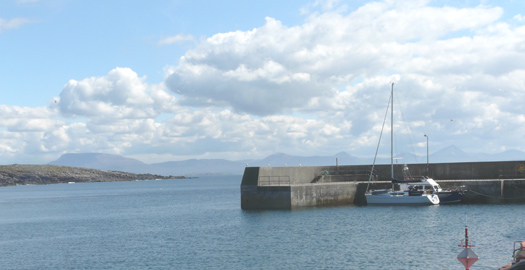
Peter Mullan's Sun Odyssey Sancerre in the little harbour at Tory Island with the Donegal highlands beyond. Photo: Peter Mullan
All the logs, including the winning ones, were featured in the ICC's 180-page Annual 2013, which Honorary Editor Ed Wheeler managed to get to the members in time for Christmas. All this is done by voluntary effort, yet the Annual would stand up to professional comparisons, as it includes informative accounts of cruises in just about every part of the world, plus a report on the ICC Cruise-in-Company to the Isles of Scilly which was an outstanding success despite coinciding with some uneven weather in June.
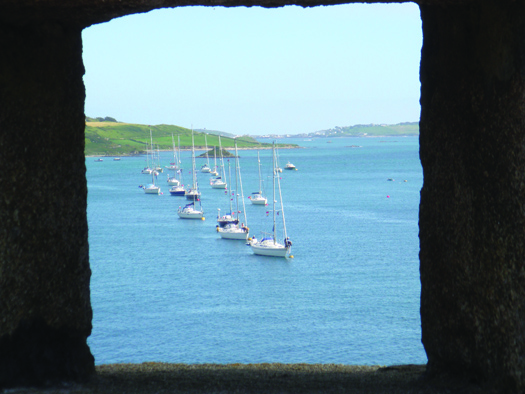
The Irish Cruising Club flotilla in the Isles of Scilly during their successful Cruise-in-Company in June 2013.

Everyone to his taste. ICC member Brian Black went to Greenland for the sixth time, crewing on Aurora. This is Kangertitiatsivaq Fjord in high summer. Photo: Brian Black
There's more to the Club than the Annual, as the ICC's programme of producing constantly up-dated Sailing Directions for the entire Irish coast in two volumes is a continuous progression, with the latest 12th Edition of the North & East Coast Book due next month from Honorary Editor Norman Kean, whose home port is Courtmacsherry.
Thus it's clear that Ireland's cruising club is a truly all-Ireland organisation, and this year it will be celebrating its 85th birthday with a Cruise-in-Company to Glengarriff where it was founded on July 13th 1929. Yet despite its obvious significance, this is a club without premises. In the final analysis, it's a club of the mind, made up of kindred spirits. Heading such a body is a mighty challenge, and the changing of the watch is always a charged moment.
Last night David Tucker of Kinsale stood down after serving his three years as Commodore, and he was succeeded by Peter Killen of Malahide. His experience in club administration is long-lived – he was Commodore of Malahide YC when it became "Club of the Year" in 1980. But it was his cruising CV which next went into overdrive, as in 1993 he voyaged north to Iceland, circled it, and then sailed back in near-record time in an S&S 30. He then moved up to a Sigma 36 which he cruised to Greenland among other places, following which he cruised even further with a Sweden 38, and then in 2004 he took on his dreamship, the Amel Maramu 54 Pure Magic.
Peter Killen seems to have cruised this very special boat just about everywhere. Not least was deep into Antarctica, where he made a memorable arrival in zero visibility with icy conditions into the natural harbour in the extinct volcanic crater on Deception Island. It was all a long way in time and distance from five boats gathered in Glengarrif in the hope of forming a little cruising organisation back in 1929. But that's the way it is with the Irish Cruising Club.



























